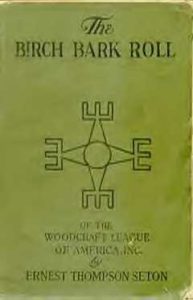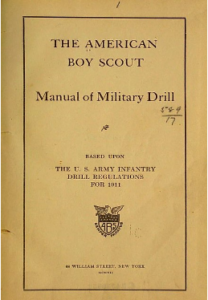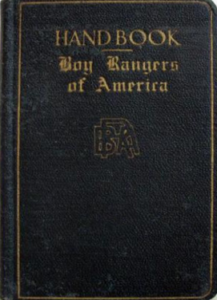Woodcraft Indians, Sons of Daniel Boone, Rhode Island Boy Scouts, New England Boy Scouts, Boy Scouts of the United States, Lifesaving Scouts of the World, Boy Rangers of America, Lone Scouts of America, National Scouts of America, Peace Scouts of California. What do they all have in common? These are all ingredients of the Mulligan Stew that is the Boy Scouts of America.
 The first Woodcraft “Tribe” started in 1901 when Seton’s property had been vandalized several times by a group of boys from the local school. Seton decided the boys needed guidance more than punishment, so he went to the school, and invited them to his property for a weekend. They were reluctant but curious. Like the 9-day Scout enclave on Brownsea Island that would come 6 years later, this weekend served as a test for the Woodcraft Indians’ program. Seton highly respected Native Americans’ reverence for nature so he consulted with Ohíye S’a (Charles Eastman) when forming the Woodcraft Indians.
The first Woodcraft “Tribe” started in 1901 when Seton’s property had been vandalized several times by a group of boys from the local school. Seton decided the boys needed guidance more than punishment, so he went to the school, and invited them to his property for a weekend. They were reluctant but curious. Like the 9-day Scout enclave on Brownsea Island that would come 6 years later, this weekend served as a test for the Woodcraft Indians’ program. Seton highly respected Native Americans’ reverence for nature so he consulted with Ohíye S’a (Charles Eastman) when forming the Woodcraft Indians.
Word got around about “Seton’s boys” and the Ladies Home Journal invited him to publish a series of articles about the program that were later combined into the handbook of the Woodcraft Indians titled the Birch Bark Roll.
The soul of the Woodcraft Indians program was conservation of wildlife and natural resources and those became essential elements of the Boy Scouts of America program when the Woodcraft Indians merged its membership with BSA in 1910.
 Daniel Carter Beard and Ernest Thompson Seton knew each other and occasionally consulted with each other, though they were very different in many ways. This was evident in the organizations they each founded. Seaton was a naturalist whose intent was to create a boys’ organization to develop character in its membership through outdoor skills and his understanding of Native American lore. Beard was more of a gadget guy whose intent was to increase circulation of the magazine he worked for by creating a boys’ organization that emulated America’s greatest pioneer and promoted patriotism and outdoor activities. Notwithstanding his initial intent, the Sons of Daniel Boone and its participants were very dear to “Uncle Dan” as he became known.
Daniel Carter Beard and Ernest Thompson Seton knew each other and occasionally consulted with each other, though they were very different in many ways. This was evident in the organizations they each founded. Seaton was a naturalist whose intent was to create a boys’ organization to develop character in its membership through outdoor skills and his understanding of Native American lore. Beard was more of a gadget guy whose intent was to increase circulation of the magazine he worked for by creating a boys’ organization that emulated America’s greatest pioneer and promoted patriotism and outdoor activities. Notwithstanding his initial intent, the Sons of Daniel Boone and its participants were very dear to “Uncle Dan” as he became known.
The Sons of Daniel Boone became the largest boys’ organization in America. When it merged its membership with the fledgling BSA in 1910, its essence of outdoor activities and patriotism became ingrained into the BSA program.
 BSA was incorporated by publisher William Boyce on February 8th, 1910. Its chief rival was the American Boy Scouts founded by rival publisher William Randolf Hearst just 3 months later. The ABS was more military in nature than BSA and many of the national and regional (department) leaders were retired generals. It was a troubled organization from the start with Hearst and several national board members resigning later that year along with the New England chapter. The Rhode Island chapter left the ABS just a few months later in March 1911.
BSA was incorporated by publisher William Boyce on February 8th, 1910. Its chief rival was the American Boy Scouts founded by rival publisher William Randolf Hearst just 3 months later. The ABS was more military in nature than BSA and many of the national and regional (department) leaders were retired generals. It was a troubled organization from the start with Hearst and several national board members resigning later that year along with the New England chapter. The Rhode Island chapter left the ABS just a few months later in March 1911.
To be clear, the ABS never merged with BSA. It simply folded in the early 1920’s after continued controversies and several name changes. But, the two breakaway chapters that became the New England Boy Scouts and Rhode Island Boy Scouts did eventually merge with BSA in 1916 and 1917 respectively.
 BSA founder William D. Boyce felt that BSA’s program didn’t serve rural boys who lived too far from other boys to form a troop. James E. West, the BSA’s first Chief Scout Executive, opposed Boyce’s program saying that 4-H filled that role so, Boyce struck out on his own and started the Lone Scouts of America on January 9, 1915.
BSA founder William D. Boyce felt that BSA’s program didn’t serve rural boys who lived too far from other boys to form a troop. James E. West, the BSA’s first Chief Scout Executive, opposed Boyce’s program saying that 4-H filled that role so, Boyce struck out on his own and started the Lone Scouts of America on January 9, 1915.
Boyce adapted the British Boy Scout Association’s Lonecraft program along with the Native American themes of Ernest Thompson Seton’s Woodcraft Indians. No adult leaders were required in his program, and there were no age limits. Lone Scouts who lived near enough could form a “local tribe”, while others could form a “mail tribe” and communicate by post. Tribes could join together to form “wigwams”. Tribes elected officers such as chief, sachem (vice-president), scribe, and wampum-bearer (treasurer).
West apparently realized his error and attempted to compete with Boyce’s Lone Scouts of America by forming the Pioneer Scout program within BSA in 1916, with little success. After prolonged urging from West, Boyce finally agreed to merge his Lone Scouts of America with BSA in 1924. The LSA became BSA’s Lone Scout program.

Chief Scout Ernest Thompson Seton developed a program for BSA named Cub Scouts of America in 1911, but it was never implemented. James E. West felt it would draw away boys from the core Scouting program. Unofficial programs for younger boys started around this time, including the Boy Rangers which was started in 1913 by a BSA commissioner, Emerson Brooks, using Native American themes as Seton had envisioned. When West learned of the Boy Rangers, he encouraged it as a separate organization.
Boy Rangers were organized as a tribe of eight boys and an adult; up to six tribes would form a lodge. Rank levels were Paleface, Papoose, Brave, Hunter, Warrior and Hi-Pa-Nac. The Great Laws of the Boy Rangers were based on the BSA version of the Scout Law.
BSA obtained the rights to Baden-Powell’s The Wolf Cub Handbook in 1916 and used it in unofficial Wolf Cub programs starting in 1918. It wasn’t until 1928 that they finally began some experimental Cubbing units for 8, 10, and 11 year old boys. With the success of the experimental units, BSA began registering the first Cubbing packs in 1930. Many Boy Ranger lodges converted to Cubbing at that time although the Boy Rangers existed into the 1940’s with some lodges continuing locally through the 1980’s.
Each of these and other organizations that merged into the Boy Scouts of America had their own practices, standards, and unique program features, yet they found common ground in their primary goal of character development for kids to prepare them for adult life. It was that common ground that eventually brought them together, but their differences made BSA stronger through adapting our program to meet the needs that the contributing organizations were filling. In the same way, our families come together to form Packs, Troops, Crews, and Ships and it is their diversity that makes these units stronger.


